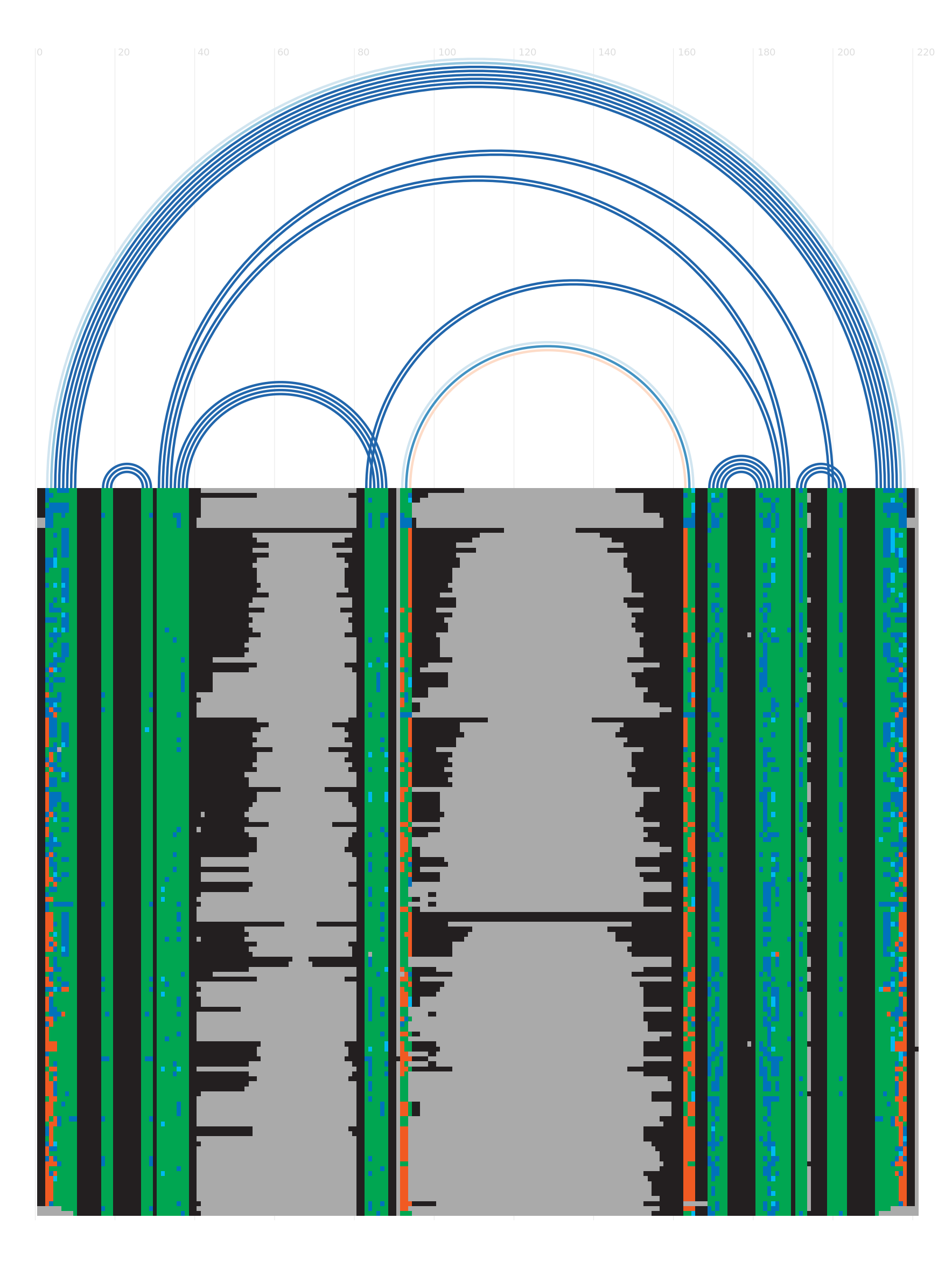Summary
Note on Riboswitches
This Rfam family FMN (RF00050) represents an aptamer domain of a full riboswitch FMN riboswitch aptamer (RFN element). Riboswitches are non-coding RNA structures that regulate gene expression in response to ligand. Each riboswitch has two main parts: the aptamer domain and the expression platform. The aptamer domain is highly conserved to precisely bind its ligand. However, the expression platform has multiple modes of gene regulation, which introduces sequence and structure variability that increases difficulty in its detection through covariance model searching. For more information see the original publications.
Wikipedia annotation Edit Wikipedia article
The Rfam group coordinates the annotation of Rfam families in Wikipedia. This family is described by a Wikipedia entry FMN riboswitch. More...
This page is based on a Wikipedia article. The text is available under the Creative Commons Attribution/Share-Alike License.
Sequences
Alignment
There are various ways to view or download the seed alignments that we store. You can use a sequence viewer to look at them, or you can look at a plain text version of the sequence in a variety of different formats. More...
View options
You can view Rfam seed alignments in your browser in various ways. Choose the viewer that you want to use and click the "View" button to show the alignment in a pop-up window.
Formatting options
You can view or download Rfam seed alignments in several formats. Check either the "download" button, to save the formatted alignment, or "view", to see it in your browser window, and click "Generate".
Download
Download a gzip-compressed, Stockholm-format file containing the seed alignment for this family. You may find RALEE useful when viewing sequence alignments.
Submit a new alignment
We're happy receive updated seed alignments for new or existing families. Submit your new alignment and we'll take a look.
Secondary structure
Species distribution
Sunburst controls
HideWeight segments by...
Change the size of the sunburst
Colour assignments
 Archea
Archea
|
 Eukaryota
Eukaryota
|
 Bacteria
Bacteria
|
 Other sequences
Other sequences
|
 Viruses
Viruses
|
 Unclassified
Unclassified
|
 Viroids
Viroids
|
 Unclassified sequence
Unclassified sequence
|
Selections
Click on a node to select that node and its sub-tree.
Clear selection
This visualisation provides a simple graphical representation of the distribution of this family across species. You can find the original interactive tree in the adjacent tab. More...
Tree controls
HideThe tree shows the occurrence of this RNA across different species. More...
Loading...
Please note: for large trees this can take some time. While the tree is loading, you can safely switch away from this tab but if you browse away from the family page entirely, the tree will not be loaded.
Trees
This page displays the predicted phylogenetic tree for the alignment. More...
Note: You can also download the data file for the seed tree.
Structures
For those sequences which have a structure in the Protein DataBank, we generate a mapping between EMBL, PDB and Rfam coordinate systems. The table below shows the structures on which the FMN family has been found.
Loading structure mapping...
Motif matches
There are 3 motifs which match this family.
This section shows the Rfam motifs that match sequences within the seed alignment of this family. Users should be aware that the motifs are structural constructs and do not necessarily conform to taxonomic boundaries in the way that Rfam families do. More...
| Original order | Motif Accession | Motif Description | Number of Hits | Fraction of Hits | Sum of Bits | Image |
|---|---|---|---|---|---|---|
| 7 | RM00008 | GNRA tetraloop | 30 | 0.205 | 312.3 |
|
| 7 | RM00024 | T-loop | 16 | 0.110 | 173.2 |
|
| 7 | RM00030 | U-turn motif | 14 | 0.096 | 154.6 |
|
References
This section shows the database cross-references that we have for this Rfam family.
Literature references
-
Vitreschak AG, Rodionov DA, Mironov AA, Gelfand MS Nucleic Acids Res 2002;30:3141-3151. Regulation of riboflavin biosynthesis and transport genes in bacteria by transcriptional and translational attenuation. PUBMED:12136096
-
Gelfand MS, Mironov AA, Jomantas J, Kozlov YI, Perumov DA Trends Genet 1999;15:439-442. A conserved RNA structure element involved in the regulation of bacterial riboflavin synthesis genes. PUBMED:10529804
-
Winkler WC, Cohen-Chalamish S, Breaker RR Proc Natl Acad Sci U S A 2002;99:15908-15913. An mRNA structure that controls gene expression by binding FMN. PUBMED:12456892
-
Serganov A, Huang L, Patel DJ Nature. 2009;458:233-237. Coenzyme recognition and gene regulation by a flavin mononucleotide riboswitch. PUBMED:19169240
-
Wilt HM, Yu P, Tan K, Wang YX, Stagno JR J Struct Biol X. 2020;4:100035. FMN riboswitch aptamer symmetry facilitates conformational switching through mutually exclusive coaxial stacking configurations. PUBMED:33103111
External database links
| Gene Ontology: | GO:0010181 (FMN binding); |
| Sequence Ontology: | SO:0000035 (riboswitch); |
Curation and family details
This section shows the detailed information about the Rfam family. We're happy to receive updated or improved alignments for new or existing families. Submit your new alignment and we'll take a look.
Curation
| Seed source | Vitreshchak A | ||||||
| Structure source | Published; PMID:12456892 | ||||||
| Type | Cis-reg; riboswitch; | ||||||
| Author |
Vitreshchak A,
Gelfand M,
Bateman A ,
Ontiveros-Palacios N ,
Ontiveros-Palacios N
|
||||||
| Alignment details |
|
Model information
| Build commands |
cmbuild -F CM SEED
cmcalibrate --mpi CM
|
| Search command |
cmsearch --cpu 4 --verbose --nohmmonly -T 30.00 -Z 2958934 CM SEQDB
|
| Gathering cutoff | 66.2 |
| Trusted cutoff | 66.2 |
| Noise cutoff | 66.1 |
| Covariance model | Download |
